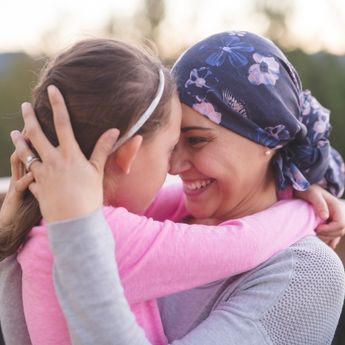 By Quinn Obrigewitch
By Quinn Obrigewitch
My mother was diagnosed with triple negative breast cancer at the age of 30, both of which are strong indicators of a genetic mutation. Triple negative breast cancer is a more aggressive and lesser-seen subtype of breast cancer that disproportionately targets young women and has fewer treatment options; often resulting in a more aggressive therapy process. This is all due to the unfortunate circumstance that triple negative breast cancer can be a hereditary pathology - commonly known as the Breast Cancer 1 (BRCA1) or BRCA2 mutations. Typically, mutations are not something to be wary of. In fact, they are a rather good thing. They are what make you different from your neighbour, or what has given you your beautifully coloured eyes, or what might be protecting you from a certain disease. Life requires genetic mutations to progress; the world adapts, and then we adapt, and the world adapts again in harmonious flux. However, people born with the BRCA1 or BRCA2 mutations are at a disadvantage against their environment.
The BRCA genes are tumour suppressor genes and can be thought of as the traffic officers of the body. In each hand, they hold one stop sign which signals to replicating cells that they have fulfilled their duty and can stop dividing. Sometimes, the environment gets too harsh, and a stop sign is lost. This is to be expected which is why there are two; BRCA1 and BRCA2 will still function normally following the loss of one stop sign. The mutation causes the loss of function of one stop sign in utero, meaning those possessing the BRCA mutations are only equipped with one stop sign. Once that is lost, cells lose their guidance signal and begin to divide uncontrollably, thus resulting in a difficult-to-treat cancer which often occurs earlier in life.
With this knowledge, it is easy to understand the essential role genetic testing has in cancer diagnosis and prevention. In fact, genetic testing is what I consider having saved my life. My mother was quick to expose my sisters and me to the danger we may face in young adulthood following her diagnosis. She was never shy to tell us that we need to be vigilant, and our 18th birthdays were marked with the exciting milestone of now being legally old enough to request genetic testing for the BRCA mutation, as per the province of Alberta’s cancer screening guidelines. I attended my older sister’s appointment with her and had the opportunity to listen to the genetic counsellor speak. My sister and I were met with a warm, safe, and comfortable environment where we drew our family tree and learned all about BRCA, what it does and why the mutation is bad. The appointment only lasted one hour but we left with a wealth of new information, feeling both scared of what our bodies could do yet relieved that we had the opportunity to act before the cancer. I was so excited to tell my friends about their stop signs.
I had my 18th birthday in May of 2018 and had booked myself an appointment to see my family doctor the following week. I remember feeling excited, rather than scared, to request my genetic testing. I had enjoyed everything I learned at my sister’s appointment a few years prior so much that I began actively volunteering with the local genetic counsellor, which mostly involved helping her organize her files. Nevertheless, I was looking forward to having her on my team and knew I could put my full trust in her to read my genetic background. My usual family doctor was on maternity leave at the time of my appointment, so I spoke with one who was standing in for her. I come from a relatively small town where everyone is quite well known to each other, so my mother’s diagnosis, battle with cancer, and subsequent health advocacy beginning about a decade prior was no secret. I was in for quite a surprise when I went to speak with the interim doctor and not only had to regurgitate my entire family history of breast cancer and other cancers, but was also met with resistance; “Who is this “genetic counsellor” you keep asking for? I have never heard of her; we don’t normally have people requesting for genetic testing”. I explained once again the breadth of my family history, my sister’s referral, and how much I needed this test. I walked out of that health clinic with a newfound confidence in advocating for myself, a smile on my face, and a referral in hand.
My appointment was booked two weeks later and fell at the beginning of June. I met with the counsellor whom I had seen 100 times prior, yet I was incredibly nervous. I was so well versed in how these appointments go that at this point I could have recited it myself, but this whole situation was beginning to feel much more real. She asked me how I was feeling, to which I responded honestly, and I was sent away for my bloodwork. Genetic testing is typically done through blood sample analysis; however, it can be done through saliva samples or a cheek swab.
The human genome can be thought of as chapters in a book, with every individual lineage holding its own, unique story. Searching for one gene in the entire genome is like sorting through the pages of a book. Upon the first time of reading the book, it can be difficult to decide where the chapter of importance will be, and so the length of the book must be read carefully and thoroughly. Once the book has been read and understood, a bookmark can be inserted into the desired chapter to make future searches easier and take less time.
My mother was the first one in my family to undergo genetic testing and patiently waited over the course of a year while her book was carefully read. My sister and I were graced with the fortune of my mother’s bookmark, and my results were delivered to me, by phone call, three months after my blood test, in September 2018. My genetic counsellor was the one to deliver the news, where she kindly asked me how I was feeling and if I would like any resources including BRCA1 support groups. I politely declined, as I felt the best people for me in that moment were my mother and sister, and that was the end of my journey with my genetic counsellor.
The following years were marked by routine cancer screening and decision making. I opted for prophylactic removal of my breast tissue to reduce my risk of breast cancer, and four years later I am happy to be living freely under normal-population cancer screening guidelines. Genetic testing offered me a brief window into my future by telling me I was missing a stop sign, where I was able to take action to keep myself as healthy as possible, for as long as possible; for the sake of myself, my friends, and my family. Two surgeries in exchange for more certainty, and all because of a silly little stop sign.






